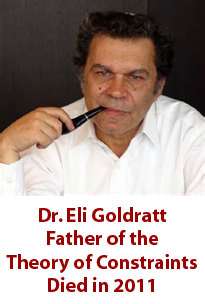 In addition to its groundbreaking thinking around TOC, The Goal was among the first business books to be presented as a novel, a technique that has been replicated many times since. In addition to its groundbreaking thinking around TOC, The Goal was among the first business books to be presented as a novel, a technique that has been replicated many times since.
In 1986, Goldratt released a sequel to The Goal called The Race. In that book, with Rogo now VP of Manufacturing at Unico, he developed in more detail what is called the Drum-Buffer-Rope (DBR) approach to material flow.
The drum is constraint or weakest link; the buffer is the material release duration, and the rope related to the release timing. The objective is to protect the weakest link in the system, and therefore the system as a whole, against process dependency and variation and thus maximize a given systems' overall effectiveness.
The DBR approach is generally paired with "buffer management," which serves as the control system that allows a company to keep a running check on the system's effectiveness. Drum-Buffer-Rope is the approach, with buffer management providing the measurement and control.
In a 2007 article, SCDigest discussed how Intel had used DBR thinking to improve its distribution performance, adopting some practices that might run counter to traditional management of DCs processes, but which delivered better total system performance (see Using Theory of Constraints to Improve Distribution Throughput at Intel).
How Goldratt Got Started
A physicist by training, Goldratt eventually left the academic world, where he was already was doing consulting for Israeli manufacturers.
He joined a called Creative Output, whose Optimized Production Technology software package is considered by many as the first to provide finite capacity scheduling for manufacturing.
However, Goldratt found that many of the company's customers were not achieving the results they should have from the tool. Researching this issue, Goldratt determined that the achievement gap was due to such factors as the ingrained habits of employees and managers, which often did not change much after the software implementation, leading to unsatisfactory results. As such, this made him one of the first to formally recognize the role of "change management" in system implementation success.
That led Goldratt to write The Goal, for which he had a difficult time finding a publisher. The book was eventually picked up by North River Press, and became a large success, and saw several additional printings over the next two decades since its original release in 1984.
However, Creative Output noticed that many companies were deciding to use TOC thinking first, without bothering with the software. This led to tensions with owners of the company, naturally enough, and ultimately led to Goldratt's exit from the company in 1985. Goldratt was later critical of almost every software company that claimed to have embraced TOC principles in its solutions.
Goldratt started the Goldratt Institute shortly after leaving Creative Output.
The Theory of Constraints continues to be widely studied and embraced, noticeably by the US military, which maintains active adoption and training in its principles.
What are your thoughts on the Theory of Constraints and Dr. Eli Goldratt? Did you get a chance to meet the man? Please let us know your thoughts at the Feedback button below.
SCDigest is Twittering!
Follow us now at https://twitter.com/scdigest |